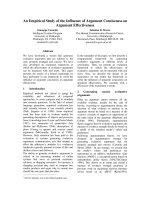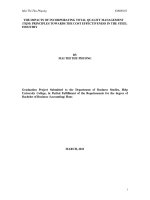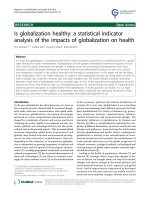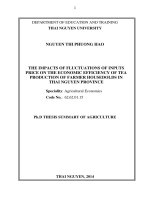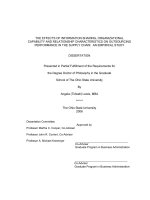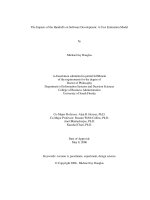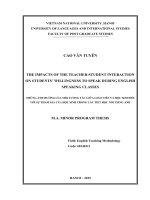The impacts of market led land reforms on corruption an empirical study of china
Bạn đang xem bản rút gọn của tài liệu. Xem và tải ngay bản đầy đủ của tài liệu tại đây (1.82 MB, 129 trang )
Chapter 1
Introduction
Background
Corruption has been a major policy concern across the globe because it
is detrimental both to economic development and political stability, and to
citizens‘ welfare. Countries plagued by widespread corruption often see
increasing income inequality, underinvestment and misallocation of resources
(Tanzi, 1998). As a country with the world‘s largest population, China has
experienced aggravation of corruption since the late 1970s with the start of
economic reforms. In 2009, Transparency International‘s Corruption
Perception Index (CPI) ranked China 79th among 180 countries.1 In the same
year, China‘s procuratorates investigated 4,1531 public officials for
work-related crime, with the recovered amounts on corruption cases valued at
7,120 million RMB (US$1,100 million or S$1,352 million).2 Corruption has
spread across various economic sectors and industries, particularly in
capital-intensive sectors such as real estate, construction, finance, customs,
taxation, and medical health in China.
Among various areas of Chinese corruption, this thesis focuses on
corruption related to land management, which has grown to unprecedented
1
See Transparency International, ―Corruption Perceptions Index 2009‖, available at
/>2
See Supreme People‘s Procuratorate of the PRC., ―Zuigao Renmin Jianchayuan Gongzuo
Baogao‖ [―Report on the work of the Supreme People‘s Procuratorate‖], available at
/>
1
proportions in recent decades and become a major focal point in the country
(Deng, Zhang, & Leverentz, 2010). Land corruption encompasses a variety of
forms such as bribery in land use rights (hereafter LURs) assignment,
embezzlement and misappropriation of land-related revenues, land grabbing,
land sales in the black market, and other abusive land use behaviors that
violate land laws and principles. A 2009 survey in Guangdong Province found
that the construction and land planning departments were perceived to be the
most corrupt among government organizations.3 The magnitude of illegal
land use by local authorities is substantial; in the 11-year period from 1998 to
2008, over a million (1,215,117) illegal land use cases involving 534,834
hectares of land were filed by the Ministry of Land and Resources, among
which 237,094 hectares were farmland.4
The rise of corruption involved in land development remains among
the most contentious social, political and economic issues in contemporary
China (Chow, 2006; Lin & Ho, 2005). Land is fundamental to successful
marketization and urbanization, and the study of land corruption is of great
importance for at least four reasons. First, illegal land-use behaviors cause
losses of state-owned-assets and government revenues. For instance, corrupt
officials may sell urban state-owned land to investors at below market prices
in exchange for bribes, making the state suffer from capital losses. Second,
3
See Guangzhou Daily, ―Guangzhou Lianzheng Diaocha Xianshi Jianshe Guotu Bumen Ju
Fubai Shouwei‖ [―Guangzhou Anticorruption Survey Ranks Construction and Land Planning
Department the First‖], available at />4
Source: China Land and Resources Almanac, 1999-2009, compiled by the Ministry of Land
and Resources.
2
land corruption widens the gap between the rich and the poor by unequally
distributing land resources to different groups. In rural-urban peripheries, local
governments and developers often take farmers‘ land at low cost and sell the
LURs at high prices, reaping huge profits from land transference.
Consequently, real estate developers and those in power are better-off, while
the under-compensated farmers become landless and often jobless, suffering
from welfare loss. Third, land corruption erodes public trust, creates social
unrest and political instability. It strikes at the legitimacy of the ruling party
and affects the wellbeing of citizens in China. In urban areas, corruption and
abuse of power are driving massive toll breakdown by force (qiang chai).
Urban residents are constantly reported to protect their property from being
destroyed illegally by real estate agencies and local governments. In rural
areas, peasants‘ petitions and protests against illegal land-use are taking place
throughout the country. Central government officials acknowledge that 40%
of peasants‘ petitions are likely related to land disputes.5 Forth, the misuse of
land leads to farmland loss, threatens food security, adversely affects
economic production and suitable development. China‘s average area of
farmland per capita is only 40% of the world average, and 7,950 hectares of
farmland were lost between 1998 and 2008.6 The situation is aggravated by
5
See The Beijing News, ―Nongmin Shangfang Sicheng Yu Tudi Youguan‖ [―Forty Percent of
Peasants‘ Petitions are Related to Land‖],
/>6
See Jianping Ye and Youhui Zhang, ―Chengzhenhua Suo Yinfa De Wenti‖ [―The Problems
Caused by Urbanization‖],
/>
3
illegal acquisition and conversion of land in rural-urban peripheries. To
address the pressure of economic development and urban expansion, large
amount of farm land is converted for non-agricultural purposes and food
security will become one of the major concerns for the central government. To
make matters worse, many pieces of land are acquired and converted in
violation of resources-protection laws and principles. These abusive and
illegal land management activities make land resources wasted, overexploited,
and ineffectively used.
The absence of corruption has a positive influence on the quality of
land management. From an environmental perspective, proper distribution of
land without abuses and corruption considers the responsibilities of protecting
natural resources and overall urban planning principles. Hence the possibilities
of overexploiting land resources can be reduced. Second, proper land
distribution without corruption is politically beneficial. A corruption-free land
administration system promotes citizens‘ sentiment of fairness and alleviate
the inequality over land use and serves the interest of local communities and
the general public. As a result, we expect the occurrence of inequalities,
disputes and social unrest can be prevented. Third, from the economic
perspective, proper and corruption-free land distribution strategies intend to
make use of land resources more effectively and more efficiently that
land-wasting behaviors cannot be tolerated. If land administration officials
abuse their power to grant or block access to land, the value of land can be
4
underestimated and underutilized.
In short, numerous social problems such as the loss of farmland, social
unrest, environment deterioration, deprivation of human rights, poverty and
inequality can be attributed to corrupt and illegal government activities in the
land sector, while a proper, accountable and corruption-free land management
system contributes to the development of a society and the welfare of its
citizens.
Research Questions and Objectives
Land corruption has become synonymous with, and surging alongside,
market-oriented land reforms in contemporary China. Both urban and rural
areas have witnessed gigantic reconstruction within the land administration
system, but urban land reforms are more influential and appear to be the
driving force behind rural land reforms in many places. Therefore, this
research focuses on urban land, with occasional reference to rural land.
Urban land reforms in contemporary China have centered around the
commercialization of LURs; more specifically, the introduction of paid land
leasing system and abandonment of free administrative allocation of land
under the socialist land management system (Zhu, 1999b). The transformation
from the state-led to market-led land allocation paradigm has been
accompanied by a rise in rampant land corruption in the 1990s (Gong, 1997;
Deng, Zhang &Leverentz, 2010). At the initial stage of land reforms (late
5
1980s to mid-1990s), the level of marketization was very low and urban land
supply was still subject to heavy state control. Restrictions on land
transference and limited access to land encouraged illegal land transactions in
the black market, besides, power was abused to obtain inside land-use
information for personal gains. In part to address the rampant corruption and
black market in the land sector, the Chinese central government decided to
reconstruct the urban land supply system. A deepening adoption of
market-driven urban land leasehold was witnessed in the 2000s. The previous
free and discounted allocation methods were gradually replaced by market-led
land pricing and allocation modes such as public tender, auction, and
quotation. The main objective was to end the perceived government monopoly
in resources allocation and to restrain local officials‘ discretion in land
licensing and permitting, in hopes that it would curb unprecedented
land-related corruption. The Ministry of Supervision, which worked
aggressively with the Ministry of Land and Resources to promote the new
policy, claimed that these tender, auction and quotation modes could reduce
government intervention in the land market and protect principles of openness
and fairness, and would be able to prevent corruption at its source.7
However, it is debatable whether this new policy has succeeded in
reducing corruption. Firstly, very few empirical studies have explored the
7
See ―Guotuziyuanbu Jianchabu Guanyu Luoshi Gongyeyongdi Zhaobiao Paimai Guapai
Churang Zhidu Youguan Wenti De Tongzhi‖[― Notice of the Ministry of Land and Resources
and Ministry of Supervision on the Implementation of the Assigned System of Commercial
Lands by Means of Public Bidding, Auction or Hanging out in a Shingle‖], available at
/>
6
association between new land policy and corruption. Secondly, there is no
consensus among existing literature on the outcomes of the new policy. Tao,
Zhang and Li‘s (2010) empirical study reported that the tender and auction
modes may reduce corruption in land sector, while negotiation and quotation
modes may lead to opposite effects. Similarly, Cai, Henderson and Zhang
(2009) found that the auction mode has been successful in reducing corruption,
whereas quotation (or two-stage auction) fosters corruption. However,
according to Liang (2009), the adoption of market-led urban land supply
policy (tender, auction and quotation) in 2002 was found to be positively
associated with corruption in the years that followed. Deng, Zhang and
Leverentz (2010) reported an escalation of land corruption between the late
1990s and 2008, which seemed to imply that the new policy had failed to curb
corruption. Given the unresolved debate in the existing small body of
literature, there is a perceived need to empirically investigate the relationship
between recent land reforms and corruption in China.
This research attempts to analyze the impact of the market-led urban
land supply mechanism: specifically, the impact of the tender, auction and
quotation modes on the occurrence and severity of land corruption in China.
The primary objectives are to examine how corruption operates in urban land
sector and how it is shaped by market-led land supply modes. Hence, I
propose following research questions in this thesis.
I.
Has the introduction of market-led land leasing modes reduced
7
corruption as academics and practitioners claimed?
II.
If not, what are the factors that account for its failure?
To answer these questions, I empirically tested the relationship
between market-led land supply modes and land-law violations. Two
hypotheses that capture the features of urban land supply system in
contemporary China—rapid transition toward market-led land supply system
in the 2000s and growing financial dependence on land resources—were
derived from the literature review. Deepening adoption of the market
mechanism in land supply is expected to help reduce corruption. Conversely,
capitalization on land provides financial motives for local governments to
engage in illegal land use. Descriptive and regression analyses were
performed on a set of panel data to test these hypotheses. As it turned out, the
market-led land supply system failed to curb land corruption. Drawing on an
institutional approach, I explore reasons why the market mechanism has failed
to deter corruption through examining the legal and institutional loopholes in
the current system.
Research Design
This research used both quantitative and qualitative approaches:
quantitative methods, to test the two hypotheses in the first research question,
and qualitative method to explain the causal pathways through which
8
corruption is fostered or curbed by market-led urban land supply system to
address the second research question. Figure 1 illustrates how this research
was carried out.
Figure 1. Research Framework
Firstly, quantitative research is carried out to estimate the relationship
between market-oriented land reforms and corruption on the basis of spatial
characteristics and time effects. Two explanatory variables capturing the
major attributes of current urban land market are used to operationalize land
reform practice: transition toward market-led urban land supply system,
particularly the adoption of a new land supply policy in 2002, and financial
dependence on land-related revenues. Additionally, I control for various
factors that may affect corruption as encompassed by the panel model, such as
law enforcement, civil servants‘ wage, government size, and so forth. A set of
panel data collected from 31 provinces between 1998 and 2008 is analyzed
using panel data analysis model. The focus of this thesis is on the 1998-2008
period because 1998 is the start of an epoch-making point for China‘s land
9
administration regime. In 1998, a comprehensive revision to the Land
Administration Law was launched; more importantly, the Ministry of Land
and Resources was created in March 1998, marking the beginning of a
nationwide land reform. I chose provinces (rather than municipalities or
counties) as the unit of analysis, for two reasons: (1) in China‘s administrative
hierarchy, provincial-level administrative units are the most important
sub-national level authorities. Central regulations and policies are often
redefined or modified at provincial level so that policies remain consistent
within the jurisdiction of a provincial unit, and any revision to the original
regulations by municipal or county governments has to be approved by
provincial governments. (2) Statistics are usually compiled and published by
provincial governments, and these were the only available data to
systematically study land issues in China. Municipalities and counties rarely
published their data in a comprehensive and longitudinal manner.
The quantitative analysis relies on official statistics compiled by
various government bodies. Major sources of data include China Land and
Resources Almanac, China Statistical Yearbook, China Financial Yearbook
and provincial yearbooks, whose features are summarized in Table 7.
Admittedly, corruption is inherently difficult to measure. Land issues strike at
the legitimacy of the ruling party hence land corruption data is usually
considered confidential and not accessible to the public. However, we can find
alternative measures to indirectly capture the level of land corruption. This
10
paper selects land-law violations defined by the Land Administration Law as
proxies of land abuses and corruption. It should be acknowledged that official
land corruption statistics—land-law violations—have limitations in their
quality and reliability. First, the number of land-law violations has seen
remarkable fluctuations between 1998 and 2008, which is perhaps caused by
shifts in the intensity of land-law enforcement from time to time. These
fluctuations may affect the validity of regression results. To address this
problem, I integrate the variable of law enforcement in the regression analysis
to ensure the fluctuations in official land corruption statistics are under control.
By controlling the variations of law enforcement, we can also control the gap
between actual land corruption level and revealed land corruption level as
many scholars argue that official statistics only reflect the intensity of
enforcement rather than the actual level of corruption. Consequently, official
land corruption statistics can provide a proper indicator of trends in the actual
land corruption level.
The second limitation of the quantitative data is that these land-law
violations do not equal to land corruption because some violations are
committed by urban residents or peasants, which have no connection with
corruption. Despite these limitations, land-law violations are entangled with
bribery, abuse of power, and fraudulence hence are able to reveal illegal and
corrupt government behaviors in land management. Based on above reasons,
official land-law violation statistics can be employed as a reasonable proxy of
11
corruption in the land sector.
At the second stage, I use a qualitative method to interpret the
regression results and to explain the causal mechanisms through which
market-led land supply policy affects corruption. If the coefficients of two
explanatory variables showed expected signs, then hypotheses in this study are
confirmed—i.e., marketized urban land supply system indeed helps to reduce
corruption. However, if the explanatory variables showed opposite signs, I
would then use the qualitative approach to explain the failure of market-led
land supply policy in curbing corruption. To obtain the qualitative data, I
conducted fieldwork in Beijing, Hebei and Shanghai between November 13,
2010 and December 18, 2010. In-depth interviews with public officials,
businessmen, college professors and local residents were carried out. The
selection of participants was based upon the assessment of participants‘
potential to provide valuable information on land corruption and
anti-corruption policies. First, public officials‘ knowledge and experience
drawn from government positions are useful for understanding the
implementation of land policies and anticorruption polices. The selected
public officials consists of two groups: one group come from land
administration organizations representing experienced influential decision
makers who demonstrate the practices of land management, the other group
was from procurators, policemen, and officials of petition office who possess
experience of handling corruption cases. Second, college professors and
12
journalists specializing in public administration and urban issues may offer
unique insight into the outcomes of new land policies and anticorruption
policies. Real estate developers can tell stories of how they compete for land
use rights in tender, auction and quotation. More importantly, they are able to
provide information on the state-business relations which demonstrate a
hotbed for corruption. Finally, local residents and peasants as main
stakeholders are directly involved in land use activities such as toll breakdown
and land expropriation, they can provide in-depth knowledge about
government behaviors in land use. Their perceptions on local governments are
extremely important for understanding the scope and definition of land
corruption. Based on the above considerations, I contacted my acquaintances
in China to find qualified participants and used a snowballing technique to
establish a valid sample frame. Existing participants who willingly agreed to
engage in the research made recommendations of other qualified participants.
Finally, 26 male and female respondents aged above 24 were chosen and
interviewed: eighteen bureaucrats, two scholars, two real estate developers,
two villagers and one journalist. The bureaucrats held positions ranging from
department chief to ordinary staff member in land administration offices,
inspection and judicial system, and other government bodies that could be
vulnerable to corruption. The interviews were conducted face-to-face or via
the internet, using self-administered list of questions. As requested by the
interviewees, and to ensure anonymity, no names or workplaces are mentioned
13
in the thesis. The questions proposed during interviews can be categorized
according to the following:
1) The perceived level of corruption and illegality in urban land market.
2) The policy-making and implementation in land administration.
3) The governance and transparency in the assignment of LURs.
4) Government-business relationship in land market.
5) The supervision and penalty of officials involved in land corruption cases.
6) The interaction between land administration officers and citizens.
It should be noted that there were difficulties encountered in obtaining
reliable and systematical data through interviews. Interviewees tended to
withhold information and refused to reveal any abusive and corrupt activities
existing in their workplaces. As such, the contents of the interview may not
accurately reflect land corruption with a high degree of certainty. Moreover,
the informants‘ personal perspectives and their relationship with the
researcher may lead to biased statements that could negatively influence the
empirical analysis. In an attempt to overcome such difficulties, many
participant observations and informal conversations were carried out. I also
conducted documentary research by reviewing existing archives, reports,
documentaries, newspapers and websites to collect valuable information
related to land corruption.
14
Significance of This Study
This thesis finds that the newly established market-led urban land
supply regime fails to resolve problems of land abuses and corruption, which
have grown continuously over recent decades. While the central government
and several scholars have articulated the virtues of the tender, auction and
quotation modes in reducing corruption (Cai, Henderson &Zhang, 2009; Tao,
Zhang &Li, 2010), this paper demonstrates the inability of market-led land
supply modes to curb corruption. It shows that institutional loopholes in the
urban land supply regime and a lack of parallel supervision mechanism have
made corruption in land sector uncontrolled. Meanwhile, the central policies
are often manipulated by local states because of the conflicting interests of
state agencies at various levels, resulting in failure in policy implementation.
Based on the above findings, this research is expected to contribute to
the literature of corruption and land leasing in China in the following aspects:
Firstly, this study contributes to current corruption literature by
empirically studying land corruption issue in the Chinese context. Although it
has been agreed that current land reforms are at the root of many social
conflicts, empirical studies on land management problems are few in number.
In particular, corruption in land development is under-explored. This research
reveals the various forms of corrupt practices in urban land supply, such as
extracting bribes, stealing land-related revenues and violating land protection
rules and so forth, adding to the body of knowledge on how corruption
15
actually operates in urban land management.
Secondly, this research project presents empirical evidence for the
effects of market-led land supply regime on corruption in land management. It
makes use of both quantitative and qualitative research methods in a
multidisciplinary framework. Panel data analysis is complemented by
qualitative data obtained from intensive interviews with local officials,
business people, journalists and experts. The combination of two types of
methodology enables us to overcome the deficiencies of relying on a single
method, so that more valid and convincing conclusion can be drawn.
Moreover, this thesis employs a multidisciplinary approach incorporating
public administration, economics, sociology and geography to study how
corruption is shaped by China‘s land reforms.
Finally, the findings of this research have important implications in the
policy arena. This research intends to show the problems in current urban land
management system and provides recommendations for improving land use
efficiency and protecting land resources. Additionally, this research goes
beyond the land sector and situates the issue of land corruption within the
broader context of the central-local relationship and the national legal
environment and, hence, sheds light on the bigger picture of institutional
reforms in contemporary China. Furthermore, it would provoke future studies
in the area of land policy especially in rethinking and redesigning the tender,
auction and quotation system.
16
Organization of This study
The structure of this thesis is as follows:
Chapter 2 presents the basis for understanding the manifestations and
causes of corruption in China‘s land sector. An operational definition of land
corruption is provided, followed by a narrative report describing the forms and
characteristics of land corruption based on 20 corruption scandals. Existing
literature on land corruption in global and domestic contexts is then reviewed.
The focal point of literature review is on the controversial relationship
between market-led land supply system and corruption.
Chapter 3 identifies the research questions by tracing the
transformation of China‘s urban land supply regime. After analyzing the
major characteristics of current land reforms, two hypotheses are derived to
predict the relationship between land corruption and market-led land supply
system.
Chapter 4 utilizes descriptive analysis and regression analysis to test
the two hypotheses. Coefficients of independent variables are estimated by
panel data analysis and the results are interpreted accordingly.
Chapter 5 explains why the market-led land supply system has
unexpectedly failed to curb land corruption. Institutional and legal loopholes
that produce risks of corruption in urban land supply process will be
examined.
17
Chapter 6 summarizes the contributions and limitations of this
research
and
offers
suggestions
for
future
study.
Finally,
policy
recommendations are made to enhance accountability and integrity in urban
land management system.
18
Chapter 2
Literature Review
This chapter reviews recent literature on abuse of public authority
springing from China‘s land reforms in recent decades. The objectives of this
chapter are to organize the knowledge about land corruption in China and to
discuss the contributions as well as shortcomings of existing literature. Firstly,
an operational definition of land corruption will be presented based on the
literature review to identify the boundary of this research. Then, the patterns
and characteristics of land corruption in China are described using 20 sample
corruption cases. Finally, major studies of land corruption in global and
domestic contexts are outlined and discussed.
Working Definition of Land Corruption
Corruption is commonly defined as the exploitation of public power for
private gains (Guo, 2008; Rose-Ackerman, 1978; Shleifer & Vishny, 1993). In
the
Chinese
context,
forms
of
corruption
include
graft,
bribery,
misappropriation, collective illegal possession of public funds, unstated
sources of large properties, abuse of power, dereliction of duty, and fraudulent
practice. In addition, many misconducts that do not constitute corruption
crime but that violate morality or communism ideology are also considered as
19
corruption, such as excessive banqueting and entertainment, womanizing,
seeking privileged jobs for relatives, and purchasing excessive facilities (Liu,
1983). Given the unique political culture in China, the concept of corruption
shall be broadened in its scope and deepened in depth. Any government
behaviors that violate laws, prevailing norms or codes of conduct should be
regarded as corruption.
Land corruption shares some common features with corruption in
other economic sectors; yet, it demonstrates distinct features because land is
the fundamental factor in economic production. This thesis proposes an
operational definition of land corruption to clarify the boundary of this
research. Land corruption is defined in this thesis as the abuse of public power
over land resources for private gains or organizational interests, or which
violates regulations, principles or prevailing norms of land use. The forms of
corruption related to land encompass all types of illegal land use behaviors by
local government officials. In this thesis, the terms ―corrupt‖ and ―illegal‖
land use behaviors are used interchangeably as both types of behaviors pursue
private gains at the expense of public interests. Furthermore, both are handled
by the Central Commission of Disciplinary Inspection (CCDI) and Ministry of
Supervision, two major anti-corruption agencies in China. Major types of
illegal land use behaviors, such as the illegal purchase, sale and transfer of
LURs, unlawful approval of land occupancy, and granting of land at a lower
price, directly or indirectly involve abusive and unlawful behaviors of local
20
bureaucrats. Finally, two types of illegal land use activities—illegal approval
of land requisition and illegal transfer of land use rights at lower prices—are
classified as malfeasance by the criminal law.8 Given the close links between
corruption and illegality in land development, the two terms shall be read as
referring to the same issue.
The next question then arises: how is corruption manifested in the
urban land sector? The presence and characteristics of corruption vary
significantly from sector to sector; thus, it is necessary to thoroughly
investigate the manifestations of corruption in land management. However,
given the sensitive and secretive nature of land corruption, it is extremely
difficult to accurately describe how corruption operates. Notwithstanding, I
collected information on 20 land corruption scandals from newspapers articles,
anticorruption report and online medias from early 1990s to 2010; these are
presented in Appendix A. While these land corruption cases represent only the
tip of the iceberg, they shed light on the forms and characteristics of corruption
in the urban land sector; hence, a basic understanding of land corruption can be
drawn from these cases.
As shown in Appendix A, the magnitude and severity of land-related
corruption seem substantial. Many land corruption cases involve high-ranking
officials (yao an) and large sums of money (da an). It is commonplace to find
8
See ―Zuigaorenminjianchayuan Guanyu Duzhiqinquan Fanzuianjian Lianbiaozhun De
Guiding‖ [―Standards of Malfeasance Crime Registration set by the Supreme People‘s
Procuratorate‖], enacted on December 29, 2005.
21
instances of provincial governors or Party secretaries accused of corruption in
the land and property market. Of the 20 sample cases, 14 involve provincial or
ministerial level officials; 10 officials were sentenced to death, demonstrating
the severity with which land corruption is punished. Deng, Zhang and
Leverentz (2009) found a positive relationship between the ranks of corrupt
officials and the amount of land involved: the higher the official‘s rank, the
larger the amount of land that was being illegally used. The average land area
involved was 3.31 hectares for provincial officials and 1.25 hectares for city
officials. The bribe size is also substantial: at least hundreds of thousands of
RMB (several hundred thousand in US and Singapore dollars) are paid to local
officials as bribes, as reflected by the Jing Fusheng and Liu Zhihua‘s cases.
Secondly, corruption cases in land leasing suggest a massive scale that
lead many scholars to label such acts ―organizational corruption‖ (Lin, 2009;
Lu, 2000) or ―collective corruption‖(Gong, 2002). Urban land leasing regime
is built on a division of labor, with each land leasing deal requiring permits
and approvals from various government departments. Horizontally, corrupt
land leasing deals require collaboration among multiple government bodies,
including party and executive leaders, land and housing officials, urban
planning officials, and even banking and judicial officials. Vertically, land
related corruption is usually initiated or protected by the chief leaders or the
―first-in-command‖ (yibashou). If the ―first-in-command‖ is involved in
22
corrupt deals, the subordinates have to follow suit,9 as exemplified by Mu
Suixin and Ma Xiangdong‘s gang corruption cases. One local land
administration official stated the group behaviors as such:
There is no real estate developer who does not have guanxi with
chief party and government leaders in our area. Normally corrupt
land deals have been ‗approved‘ by the leaders; we are just
following that command. We land administration officials do not
possess such discretion to initiate corrupt land deals.10
Thirdly, forms of corruption such as bribery, nepotism and favoritism
are frequently observed in land corruption cases. Among the 20 sample cases,
at least 15 officials were accused of accepting bribes, while other forms of
corruption such as embezzlement and misappropriation appeared to be
regarded as less serious than bribery. This finding is consistent with
Wederman‘s study (2004). Continuous budgetary reforms may have prevented
the occurrence of direct theft of public assets such as embezzlement and
misappropriation, while public-to-private corruption prevails in the reform era,
along with a thriving real estate industry. Real estate companies that want to
maximize profits tend to bribe local officials to obtain land at the lowest
possible costs.
The preceding section presented the operational definition and major
9
This behavior is described by the report ―Ten Characteristics of Chinese Corruption‖, China
Report 2004, 40, p.107.
10
Interview with local land administration officials on November 18, 2010.
23
forms of corruption in China‘s urban land sector. The next section reviews
current literature to understand why land corruption prevails in both global
and national contexts.
Studies of Land Corruption in a Global Context
Corruption is a phenomenon that exists in many economic sectors, but
it is only in recent years that land-related corruption has attracted close
attention at the international level. Land administration is now perceived to be
one of the most corrupt sectors in many countries. Transparency International
(2009) finds that after the police and the court, land services are the most
prone to corruption, ―in the Middle East and North Africa, the most
bribe-prone institutions are reported to be those handling procedures related to
buying, selling, inheriting or renting land. In EU countries these land services
along with healthcare are most vulnerable to petty bribery‖ (p.3). However,
detailed documentation of corrupt activities in the land sector is a relatively
recent phenomenon. For many years, corruption studies have focused on
decentralization, liberalization and privatization of state-owned enterprises
(SOEs) while land-related corruption has been given scant academic attention.
Nevertheless, corruption in the land sector has emerged an important research
subject in urban economics and corruption studies.
Recent newspaper articles and scholarly works suggest that developing
countries and transitional economies are plagued by corrupt land management
24
that impedes sustainable development (Knox, 2009; Strong, 2003). In a study
on urban land privatization in Ukraine, Strong (2003) reported that in Kyiv a
builder must pay bribes at various stages of land and construction permitting.
In addition, prospective investors had no access to information related to land,
which then discouraged investment. Improper land leasing modes also
produced risks of corruption, ―a preference for negotiated sales of land rather
than auctions sometimes reflects favoritism and bribes in the privatization
process‖ (p. 200).
Another post-socialist country, Vietnam, has also been plagued by
serious corruption in the land sector. The World Bank‘s (2011) report,
Recognizing and Reducing Corruption Risks in Land Management in Vietnam,
argued that ―corruption is most likely to occur when an official or office has a
monopoly, when the official or office has a great deal of discretion over how
the decision is taken, and when there is little accountability for that decision or
transparency, which might make it harder for the corruption to proceed
unabated‖ (p. xiv). The risks factors for corruption embedded in Vietnam‘s
land management system include poor dissemination of land-related
information, unnecessarily complex and time consuming procedures, improper
and non-transparent settlement of complaints, ineffective oversights of media,
and so forth. Information dissemination and transparency in land management
was also emphasized in another World Bank report on Vietnam, titled Survey
Report on Information Disclosure of Land Management Regulations (Nguyen,
25

